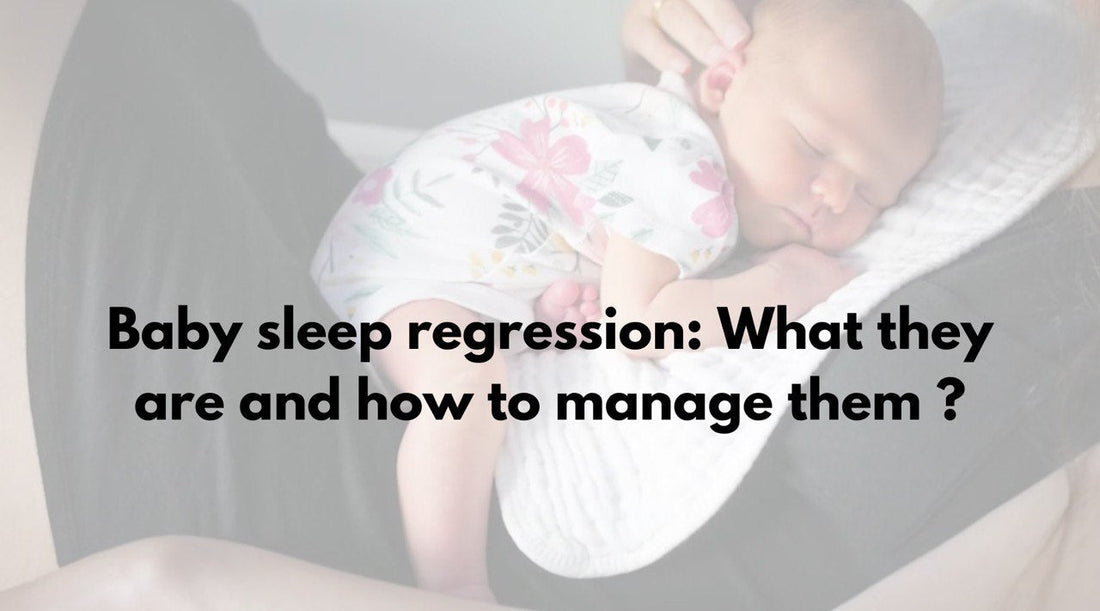
Baby sleep regression: What they are and how to manage them
Share
Has your baby’s once-predictable sleep suddenly turned upside down? you might be facing a sleep regression—or what some call a temporary “sleep bump.” These phases can be stressful, but understanding what’s happening (and how to respond) makes them easier to navigate.
What is sleep regression?
A sleep regression is a sudden setback in a baby or toddler’s usual sleep routine. For example, a baby who previously napped well may suddenly resist naps for a week or two, or a toddler who typically sleeps through the night might begin waking frequently. These disruptions can appear at different ages and often coincide with developmental changes or other life events.
Why sleep regressions happen
Several factors can trigger sudden changes in sleep:
Brain and developmental leaps—like the classic 4-month sleep shift
Reliance on certain sleep “props,” such as being rocked or fed to sleep
A schedule that needs adjusting as your child grows
Illness or teething discomfort
Travel, moves, or other disruptions in routine
Major milestones—rolling over, sitting, crawling, standing
Not every child will experience a noticeable regression at the same time. Some glide through these stages without much disruption, while others hit several bumps.
How long do regressions last?
The duration depends on what’s causing the disruption and how you respond. If an illness triggers poor sleep, your child may return to normal once they recover. But if the challenge is linked to how your baby falls asleep—like needing to be rocked—sleep issues can persist until they learn to settle independently.
Common ages for sleep regressions
Although timing varies, parents often notice patterns at these stages:
|
Age |
Typical Triggers |
|
3–4 months |
Maturing sleep cycles and brain development |
|
7–10 months |
Teething, separation anxiety, transitioning from three naps to two |
|
14–18 months |
Moving to one nap, testing independence and limits |
|
Around 2 years |
Nap refusal, boundary testing, arrival of two-year molars |
Export to Sheets
3–4 months: Around this time, babies’ sleep begins to resemble adult sleep with defined cycles. If they depend on help to fall asleep, more frequent night wakings can appear.
7–10 months: Increased mobility, teething and separation anxiety can make bedtime challenging. Dropping from three naps to two often leads to overtiredness for a short period.
14–18 months: The shift to a single daily nap plus a growing sense of independence often results in bedtime battles.
2 years: Toddlers may resist naps, push bedtime limits and experience teething from their second molars.
It’s also common for sleep to dip whenever your child is mastering a big milestone—such as rolling, crawling or walking—even if it doesn’t match these typical age windows.
Other triggers beyond development
Sleep disruptions can also follow illness, travel or significant family changes such as a move or the arrival of a new sibling. Children may seek more comfort during these times, and parents often temporarily alter routines to help them settle.
Signs of a sleep regression
Look for sudden shifts in your child’s normal patterns, such as:
At night
Difficulty settling at bedtime
Increased night wakings
Early-morning rising
During the day
Shorter naps or skipped naps
Nap resistance
6 strategies to handle sleep regressions
Reassess daytime sleep. As babies grow, their nap needs change. Too much or too little daytime sleep can lead to night wakings. Adjust nap frequency according to age.
Fine-tune the schedule. Make sure nap and bedtime align with your child’s developmental stage. A slightly earlier bedtime after dropping a nap can help.
Stay patient. When babies master new skills, they often want to practice them—sometimes in the crib. Give plenty of practice time during the day and allow a few weeks for sleep to settle.
Teach independent sleep skills. If your child relies on rocking or feeding to fall asleep, they may wake more often. Gradually help them learn to fall asleep without assistance when developmentally appropriate.
Reset expectations gently. During a regression, parents may offer extra help at bedtime. Once the milestone or nap transition passes, you may need to re-establish usual routines so your child relearns how to settle on their own.
Seek expert advice if needed. If you’re unsure whether a sleep disruption is typical, or you’d like a personalized plan, consult a pediatrician or a certified sleep consultant.
When to contact a doctor
While regressions are usually normal, check in with your healthcare provider if you notice:
Persistent fussiness or signs of pain
Ongoing feeding difficulties or poor weight gain
Fever, rash, lingering cough or vomiting
Unusual sleepiness or difficulty waking
Any change that simply feels “off” to you
Key takeaway
Sleep regressions are a normal part of your child’s development. By maintaining consistent routines, offering comfort when needed and gently encouraging independent sleep habits, you can reduce their impact. With time, your baby’s sleep will settle again—and those long nights will become a distant memory.
